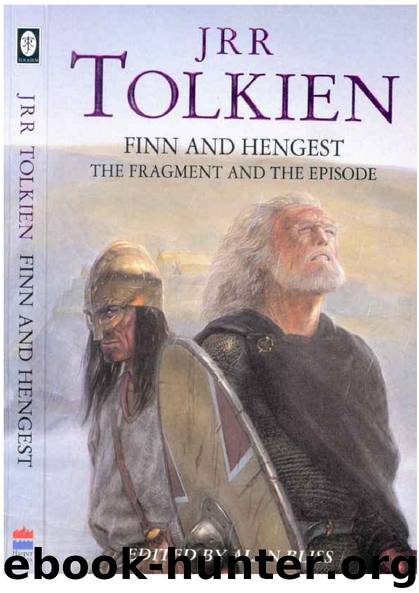Finn and Hengest J.R.R Tolkien by Tolkien J.R.R

Author:Tolkien, J.R.R. [J.R.R., Tolkien,]
Language: spa
Format: epub
Publisher: HarperCollins
Published: 2010-12-27T14:10:56.078000+00:00
TEXTUAL COMMENTARY
39 Hickes Ne nefre swa noc hwitne medo. Sel forgyldan. The emendation usually accepted is swanas for swa noc. It is not sufficiently observed that swanas is here virtually a hapax legomenon. It does not else occur in verse, and if we accept the emendation we are obliged also to assume that, like scealc, ceorl, eorl, hyse, hæleþ, etc. it was used in verse (though not by chance recorded otherwise) as a ”man”-word, i.e. in a more general sense. In prose it means ‘(swine)herd'. This verse use would be one more instance of the approach of the OE poetic vocabulary to the Scandinavian - this use of swan is more like ON sveinn than Old English. In Old Norse, sveinn means ‘boy, lad, page, esquire’; the latter - if the emendation is right - must be seen here. OS
sven means ‘swineherd’. OHG svein means ‘servant, herd’. The especial association of swān with “swine” is probably later in Old English and Old Saxon, and possibly due to the sound - the words swīn and swān may not be connected etymologically. More probably swān is originally connected with the reflexive pronoun (IE swe- se-); cf. swæs ‘one's own, dear’. Thus *swaina-
would mean ‘belonging to one's own household, personal retainer’.
At any rate some noun beginning with s appears to be required by the metre; but the line is odd, and corruption - possibly pre-Hickesian - is not unlikely, even the loss of a certain amount of matter. The difficulty is not really got over by the emendation of hwitne to swetne. The unlikely epithet is not probable as a corruption of the obvious swetne - and (though only as late as the eighteenth century) the epithet “white” is found applied to mead. A possible reconstruction might be:
ne nefre swanas sel forgyldan
hwitne medo [heardgesteallan].15
43 It is unfortunately far from certain who the wund hæleð is, or on what side.
It appears most probable that he is an attacker (a “Frisian” if you like, though this begs the question rather), and the folces hyrde (46) the leader of the attackers - probably Finn as overlord of the assembled tribes. There is, then, a distinct pause at duru heoldon (42), and the text should be printed with the paragraph break at Đa (43). This is good, because it throws into relief the 15 [For a parallel to this passage see Beowulf 7633-8; for closer Celtic parallels see P. L. Henry, “Beowulf Cruces”, Zeitschrift für vergleichende Sprachforschung l xxvii (1961) 140-59, pp. 154-6.]
89
Download
This site does not store any files on its server. We only index and link to content provided by other sites. Please contact the content providers to delete copyright contents if any and email us, we'll remove relevant links or contents immediately.
Still Me by Jojo Moyes(10813)
On the Yard (New York Review Books Classics) by Braly Malcolm(5396)
Eleanor Oliphant Is Completely Fine by Gail Honeyman(5090)
A Year in the Merde by Stephen Clarke(5082)
The Bookshop by Penelope Fitzgerald(3628)
Surprise Me by Kinsella Sophie(2994)
How Music Works by David Byrne(2969)
Pharaoh by Wilbur Smith(2883)
Why I Write by George Orwell(2783)
A Column of Fire by Ken Follett(2494)
The Beach by Alex Garland(2433)
The Songlines by Bruce Chatwin(2423)
Churchill by Paul Johnson(2374)
Aubrey–Maturin 02 - [1803-04] - Post Captain by Patrick O'Brian(2216)
Heartless by Mary Balogh(2175)
Elizabeth by Philippa Jones(2082)
Hitler by Ian Kershaw(2053)
Harry Potter and the Cursed Child by J. K. Rowling & John Tiffany & Jack Thorne(1976)
The Patrick Melrose Novels by Edward St. Aubyn(1910)
